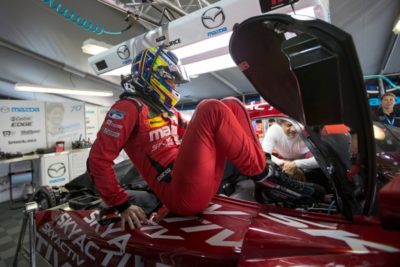While the TUDOR United SportsCar championship enters the final stages of the 2015 season, SpeedSource, the Mazda factory team, is pushing hard to test the latest iteration of the Mazda gas-powered prototype engine in preparation for next season. This week, the team completed a test at Road America and have additional test days planned in the near future. Mazda factory driver Tristan Nunez describes the challenges of testing for a driver.
Many people outside of the racing world get confused when they hear about a team that is “testing.” Some think it’s a written test, others think it’s just a practice session while others believe it’s the engineers looking over the electronics and making sure it all works. Hopefully my explanation will help clear up the confusion.
Testing can be one of the most mentally draining tasks for a driver. I can’t speak for the engineers, but I’m sure its equally as challenging for them. Testing requires a driver’s full focus, because without accurate and in-depth driver feedback of how the car is reacting, the test is a complete waste.
For the driver, testing is not about going the fastest you can, and then expecting the engineers to make decisions purely on the data generated by the on-board systems. The job of the driver is to be consistent each lap, so the changes can be truly compared. If the driver is making mistakes or pushing too hard, that data is not reliable.
The relationship and communications between engineer and driver is crucial. Both need to speak the same language, and this language takes some time to get used to. I call it a language because every team has their own version of how to talk about what the car is doing. This communication is very important. It is the driver’s responsibility to tell the engineer where the car can improve – whether that’s high-speed or low-speed stability, on- or off-throttle, braking and much more. We really get deep into details reviewing every point of the corners, sharing how the car is handling in the entry of a corner, at the apex and finally the exit of each corner. The engineer must be comfortable with the driver feedback so that he or she can make informed decisions about the changes that need to be made to improve the car.
Because the time on-track during any racing weekend is very limited, a team uses testing to take chances with the set up or to push the engine to its maximum to see what the car is capable of doing. You have the time to take risks trying new things you wouldn’t do on a race weekend. In today’s TUDOR series events, if you’re using the practice sessions to experiment or to make big changes, you’re probably not going to be very confident when the race begins.
Testing can also be very physically draining for a driver. The typical test for a driver is many short stints on the track, repeatedly in and out, usually 5 to 10 laps each run with short stops to make quick changes. For a full test day, we might drive more laps than we would in a race. (In a typical two-hour, 40 minute race like this weekend at Road America, each driver would be in the car roughly 90 minutes or less.) The hours in the car really take a toll, and a driver must rely upon his or her physical training to remain sharp. Driving a race car is always very physical and it can be painful and draining. When you’re racing in close competition, your brain blocks out the pain and strain your body is going through. But, testing a single car on-track can allow your mind to drift towards sore muscles or fatigue, which is never a good thing.
Just as the extensive physical training we do helps prevent our minds from drifting, the more testing and simulation work our team does means we can come into a race weekend properly focused on the smaller details that will make a difference in the race.
They say a race is won or lost in the preparation, and that makes test days critically important for the team and drivers if they hope to have any chance of victory.


 ACCESSIBILITY
ACCESSIBILITY